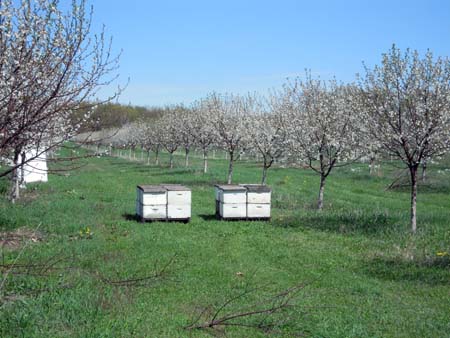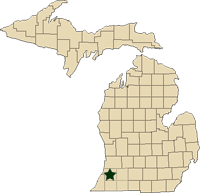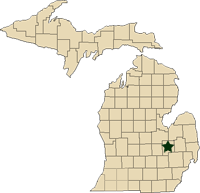Regional reports on Michigan fruit – April 3, 2012
MSU Extension educators’ pest and fruit updates for Michigan.
This week’s regional reports:
- Southwest Michigan - Mark Longstroth, Bill Shane, Diane Brown
- Southeast Michigan - Bob Tritten
- Grand Rapids Area Small Fruit – Carlos García-Salazar
Southwest Michigan – Mark Longstroth, Bill Shane, Diane Brown, Michigan State University Extension
|
Plants seemed to stand still last week. Highs last week were 20 to 30 degrees cooler than the summer-like weather earlier in March, with highs near 80 and lows in the 50s. Lows near freezing temperatures on Monday (March 26) were characterized by winds of about 10 mph. Temperatures were warmer Tuesday morning (March 27). The coldest temperatures were Thursday morning (March 29).
There is a chance for freezes again on Thursday and Friday this week (April 5-6). This will be another cool week with highs near 60 and lows generally below 40. This will keep plant growth slow. Plant development is still about a month ahead of normal. Soil temperatures have fallen from the 50s to the upper 40s. Soils are moist.
You can check for a local weather station at Enviro-weather. Our growing degree day totals are two times higher than average. You can check summaries of weather or compare the current growing degree days between stations. It is unusual that there is very little difference between stations. Stations to the north (Fennville) and close to the lake are cooler and lower sites are generally warmer except on calm mornings.
Tree fruit
The bloom has progressed slowly this last week due to the cool weather. Some growers had problems getting bees quickly enough, but generally there appear to be enough bees now. Recent rains were too short and cold to be brown rot or apple scab infections.
Apricots are at shuck split.
Peaches are in the shuck. There are still a few late blooms. Oriental fruit moths are being trapped in good numbers. Adult emergence probably began with the warm weather on April 1. Protectant sprays should be applied 100 to 150 GDD base 45 after biofix. Young peach plantings without pheromone disruption for oriental fruit moth should receive controls to protect new shoots from the larvae. There is a growing degree model for oriental fruit moth on Enviro-weather.
Nectarines should be protected against feeding by western flower thrips. The tiny thrip larvae scar the young fruit. Tarnished plant bug damage peach fruit as the end of the developing peach or nectarine begins to stick out of the shuck. Growers should monitor for both thrips and tarnished plant bugs to determine the need for control measures.
Sweet cherries are generally in the shuck. Watch for conditions favoring brown rot. Leaves are beginning to emerge and protectants for cherry leaf spot will be needed. Cherry leaf spot can only infect mature leaves with functional stomates.
Tart cherries are still in bloom, and have been at this stage for about a week. Full bloom normally occurred at the beginning of May. The trees are beginning to leaf out. Controls for cherry leaf spot need to be applied to maintain the leaf canopy for the fruit.

Bee
hives in a young tart cherry orchard, taken Monday, April 2, 2012.
Photo
credit: Mark Longstroth, MSUE.
In plums, Japanese plums are in the shuck. European plum bloom is ending. Black knot requires wet conditions for infection and growers have been applying controls.
Apple bloom is still in the early stages. Jonathans are at early king bloom. Golden Delicious is just beginning to open. Apples normally are at full bloom May 6-9. Friday, March 30, was not an apple scab infection period due to the cold, wetting period. Growers can use the scab infection tool on Enviro-weather to track when scab symptoms will be visible. No insecticides should be used at bloom time to prevent bee poisoning. Bloom signals the time to be monitoring conditions favoring fire blight – Enviro-weather has two methods for tracking fire blight episodes.

Golden
Delicious flowers at full pink, ready to open on a warm day. Taken Monday,
April 2, 2012. Photo credit: Mark Longstroth, MSUE.
Pear bloom is ending. Growers will need to protect against pear scab and watch for fire blight conditions.
Small fruit
Grape growth has slowed with the cooler temperatures. There are one to two leaves out on Concord and Niagara juice grapes. Vinifera wine grapes have reached budburst. The most advanced variety of grape at Southwest Michigan Research and Extension Center (SWMREC) in Marquette had shoots 3 to 4 inches long on Saturday (March 31). We are moving into the stage of development where Phomopsis becomes important, particularly if Phomopsis was a problem last year. The first sprays to protect against Phomopsis should be applied as the flower clusters become exposed. Temperatures in the 60-70 degree range are optimum for Phomopsis, and require only six- to 10-hour duration of wetness for infections to occur.
Blueberries are at pink bud and bloom is beginning in early varieties such as Bluecrop. Colder weather has caused leaves to redden due to cold stress. Friday’s (March 30) rain was a mummy berry infection period. Mummy berry trumpets were scarce. Most of the trumpets observed last week were small. Growers should scout mummies for newly emerged trumpets and monitor the likelihood of rain and be ready to apply controls for mummy berry.
Strawberry flower trusses are still in the crown in many matted row plantings, but growers report trusses emerging from the crown on warmer, sandy sites. Small fruits are forming on the strawberries grown on raised beds with black plastic at SWMREC. Both growers who irrigated and did not make ice last Tuesday (March 27) report no damage.
In brambles, shoots are expanding and new leaves are unfolding. Orange rust symptoms can be found on wild black raspberries.
Upcoming meetings
Our regular Monday fruit meetings start on April 9 at Fruit Acres Farms at 5 p.m.
The first in-season grape meeting is scheduled on April 25 at SWMREC from 3 to 8 p.m. This meeting will feature sprayer calibration, rate controllers and sprayer setup for early season canopies.
Southeast Michigan – Bob Tritten, Michigan State University Extension
|
Weather
An earlier, April-like weather pattern has persisted over the last week, bringing much cooler daytime high temperatures and much colder morning lows. This has slowed the growth rate of our fruit crops, almost to a point of standing still. We have had a good number of mornings with temperatures in the very low 30s, but none have been a threat to most of our fruit crops, with the exception of strawberry farms where the flower truss are out of the crown and frost protection has been needed.
Our early warm season is running nearly a month ahead of normal in terms of growth stages, and even more than that in terms of degree day totals. In fact, it is hard to relate to the exceptionally high number of degree days we have accumulated this growing season. We are not sure how they will relate to the normal growth and development of our fruit pests this season. I continue to see very little spread in growth stages from south to north, as I do most years. We are generally vulnerable to frost and freeze events for the next five to six weeks.
Soil moisture supplies are adequate for most of the region, with much above normal for the southern two tiers of counties. I have heard several reports of 3-plus inches of rain at several fruit farms in this part of the region.
Growers have moved in bees for apple pollination, where bloom is expected later in the week. As I shared in last week’s report, we have had excellent honey bee survival through the winter, with almost all hives surviving.
|
Southeast Michigan Growing Degree Day Totals for March 1 to April 2 | |||
|
Location |
GDD42 |
GDD45 |
GDD50 |
|
Commerce (Oakland) |
309 |
252 |
172 |
|
Emmett (St Clair) |
290 |
236 |
160 |
|
Flint (Genesee) |
329 |
272 |
190 |
|
Lapeer (Lapeer) |
326 |
271 |
189 |
|
Petersburg (Monroe) |
337 |
276 |
188 |
|
Pigeon (Huron) |
275 |
223 |
153 |
|
Romeo (Macomb) |
293 |
238 |
158 |
Tree fruits
Apples are at pink, with just an occasional open flower on pollinators just beginning to be seen. Spotted tentiform leafminer adults are being caught, but in even lower numbers than last week. There are no other insect trap counts to mention, as all has been very quiet on the insect side. We are continuing to catch apple scab spores with each wetting event at both of our monitoring stations. Some growers have not had an infection period, and others have had three infection periods.
The full extent of the freeze injury is still playing itself out. It appears that there is a lot of king bloom loss in apples from the Ann Arbor area and to the north. There is also some side bloom damage. I estimate that where there is damage, we have lost almost half of the bloom. There are enough viable apple flower buds for a full crop, with the outside chance of an excellent crop.
Pears are at early first white bud. Pear psylla adults have been flying for four weeks, with egglaying and hatch taking place as well. While there is flower bud loss on pears, I am seeing enough buds for a full crop.
Peaches remain at full bloom where they have been for almost 10 days now, although the bloom looks withered from all of the freeze/frost events. Brown rot sprays have been applied at most farms. There appears to be little to no freeze damage in peaches.
Sweet cherries also remain at full bloom. I am seeing extensive flower bud damage in sweet cherry, with most being killed. The bloom that was hanging on the bottom side of the branch seems to have pulled through the freeze event. Brown rot sprays have been made.
Tart cherries are mostly at full bloom and have moved faster this last week than any other fruit crop. Brown rot sprays are going on. Almost half of the flowers that I have checked have been damaged.
Plums remain at full bloom for European types and petal fall for Japanese types. Brown rot sprays have been applied. There is extensive freeze damage in Japanese types and minimal in European plums.
Small fruits
Strawberry flower trusses have emerged from the crown at many farms, so growers need to be getting irrigation systems ready for frost protection. On farms where flowers trusses emerged before the big freeze event of March 26-27, growers have needed to frost-protect three to five times in the last week. As soon as the flower clusters emerge from the crown, it is time to remove the straw mulch. Look for a more extensive article on straw removal later in the day or early tomorrow morning. The leaves on berries that were frost protected look rough.
Raspberry leaves continue to emerge for summer fruiting types and new canes continue to emerge from the soil for fall bearing types. Many of the emerging canes and leaves were badly burned from the freeze event. These should recover nicely in a few weeks.
Blueberries are at early pink bud. I do not see freeze injury in any blueberry planting that I have visited in the last week.
Grapes are at bud burst, with a good number of buds being burned back or damaged from the freeze.
Grand Rapids Area Small Fruit– Carlos García-Salazar, Michigan State University Extension
Growth and development of all small fruit crops has continued without major incidents. After the spike in temperatures that occurred in March, daily maximum temperatures have remained between the low 60s and upper 40s with minimum temperatures above the freezing point. This drop in temperature to more seasonal conditions has slowed down the growth and development of blueberries, strawberries and raspberries.
There were light spring frosts in all of the Grand Rapids area, but no significant damage to small fruit crops has been reported. On March 28, 30 and 31, low temperatures dropped below the freezing point, but remained above the critical temperatures to cause significant damage to our major small fruit crops, especially to blueberries and strawberries. Minimum temperatures observed in the region during those days were 28 and 29°F. However, the daily maximum temperatures fluctuated between 37 and 51°F. Blueberries that were in the early to late pink stage can stand those temperatures without having significant damage. Blueberry growers need to be aware that there is winter damage to flower buds, but this damage is related to cold temperatures that occurred on February 8-11 when the daily minimum temperatures fluctuated between 3 and 15°F. These temperatures caused some flower bud damage that average 14 percent. The damage can be seen as necrotic spots in the center of flower clusters.
Blueberry development in the Grand Rapids area goes from the “early to late pink” stages with shoot extension already in progress. At these stages, blueberries are susceptible to mummy berry shoot infections. Weather conditions in the region are favorable for early mummy berry attack if no preventive measures are taken. For the past few days, there have been several raining days in the region with precipitation accumulation amounting to 1 inch. Morning low temperatures are creating heavy dew that is conducive for mummy berry infections.
On the other hand, summer raspberries are at the first leaf unfolding stage and strawberry fields are showing newly emerging leaves growing from the crown of the plants.
Although no significant damage has been observed after the freeze/frost events of the past days, growers need to be alert for possible spring frost/freeze problems. Therefore, those with frost protection need to test and calibrate the sprinkler irrigation system, temperature recording devises, and water supply. The University of California, Davis Cooperative Extension has developed an excellent training presentation on the basics of frost protection for fruit crops.
We would like to remind our blueberry growers about the pre-season meeting that will be conducted on April 5 at the MSU Trevor Nichols Research Center, 6237 124th Avenue, Fennville, Mich. (see map).
The purpose of the meeting is to provide growers with updates on issues related to insect, disease and weed management, frost protection, GAP and traceability. We also will be sharing information from the MDARD Nursery and Export Program on a potential export program to ship blueberries to Canada. In addition, joining us will be industry representatives from the Michigan Blueberry Advisory Committee, North American Blueberry Council and U.S. Highbush Blueberry Council.
Finally, our goal is to obtain feedback on priorities for research and extension to guide our programs. This meeting is free. However, if planning to attend, we encourage growers to pre-register. This will provide us with an estimate on the number of handouts and refreshments needed for the meeting. Growers attending this meeting will receive two RUP credits for re-certification. For pre-registration, please contact the Ottawa Extension Office at 616-994-4580.
For all other information, call Carlos García at 616-260-0671 or Mark Longstroth at 269-657-8213.



 Print
Print Email
Email






